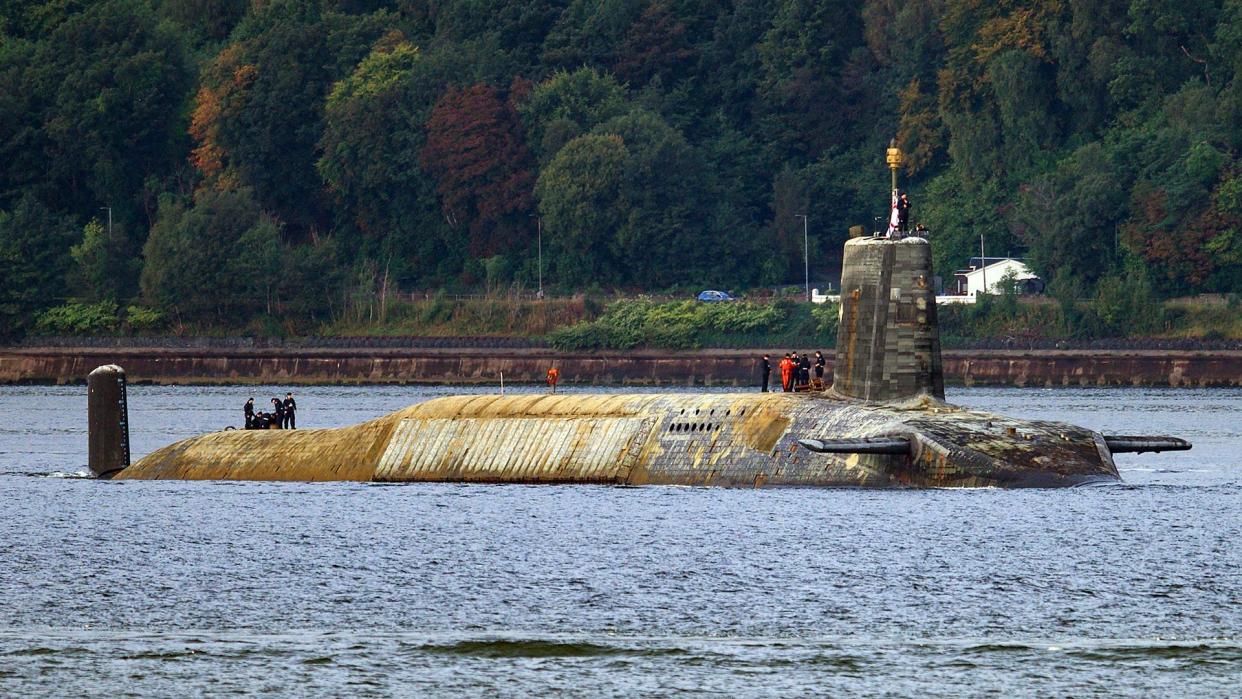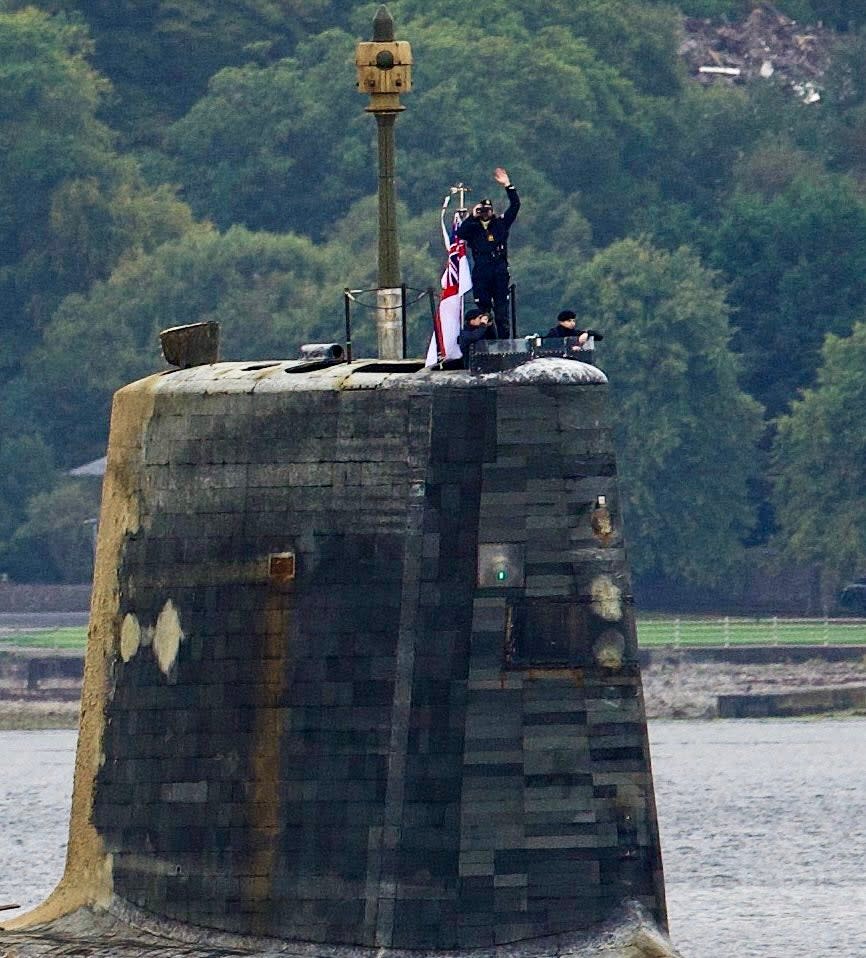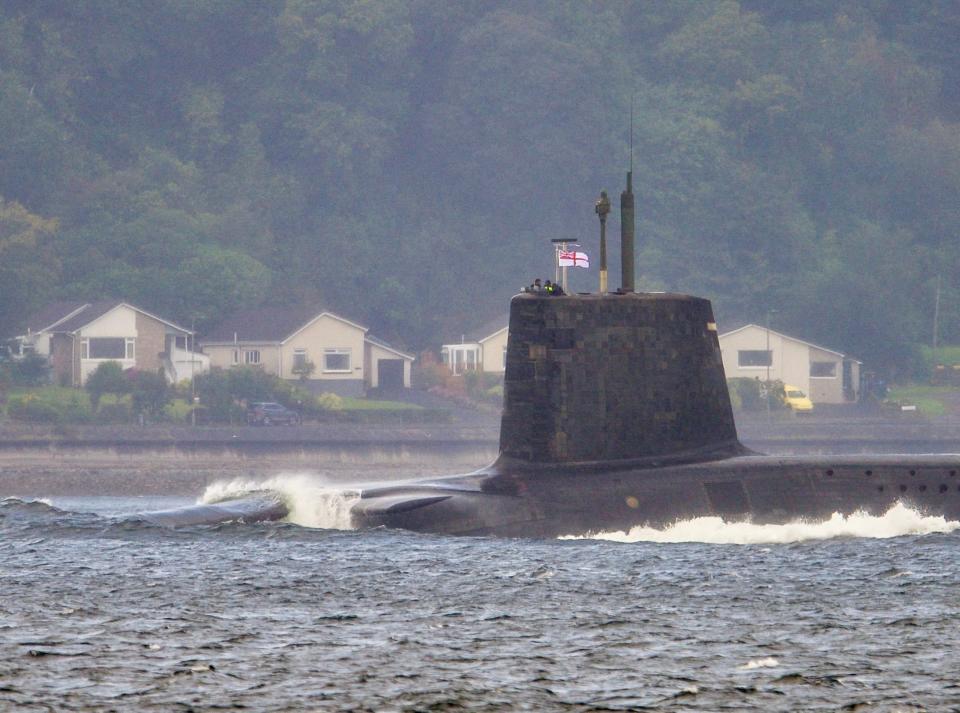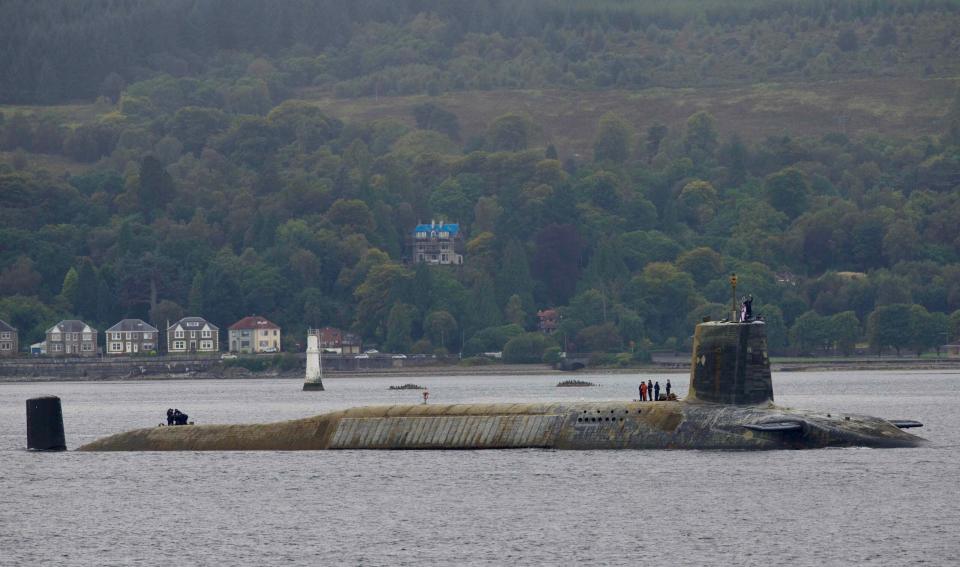Vanguard Submarine Arrives Home Absolutely Caked In Algae

Here at The War Zone, we’ve seen our fair share of naval vessels looking, how shall we say, worse for wear. Long deployments at sea, reduced crew sizes, and heavy operations tempos can lead to the formation of heavy rust and corrosion on surface combatants. Compared to seamen aboard surface vessels, however, submariners don't have the luxury of ease of access to most of their vessel's structure to keep corrosion under control and the grime off, even if they wanted to. Ballistic missile submarines whose job it is to go find a hole in the ocean to hide for long periods of time spend little time on the surface regardless.
Recent images of a Royal Navy Vanguard class nuclear-powered ballistic missile submarine (SSBN) taken by Sheila Weir — captured after the sub allegedly completed a six-month-long deterrent patrol — underscore the immense beating these leviathans of the deep can take while on missions for long stretches of time. The missile boat looks like a sea monster that has emerged from a long slumber at the bottom of the ocean.

The photos in question were taken as the Vanguard class submarine returned to HM Naval Base Clyde, which is also known as Faslane, on the west coast of Scotland, earlier today. Which specific submarine within the Vanguard class this was — there are four in total — and where it ventured to during its six months at sea remain unknown. Secrecy surrounding the movements of these SSBNs is standard practice for the Royal Navy. One British SSBN always remains on patrol from HM Naval Base Clyde at any given time to ensure the country’s second strike nuclear deterrence remains credible. Since 1998, the Royal Navy’s SSBNs have provided the U.K.’s sole nuclear weapons capability.

What is immediately clear from the imagery is just how rough the sub looks. The surface of its hull is covered in a brownish-green hue, a very severe example of “marine [or bio] fouling” — the buildup of various marine organisms on vessels’ surfaces. While anti-fouling paints can be applied to help prevent this, a technique the Royal Navy and U.K. Ministry of Defense continue to explore, the problem cannot be stopped entirely, as the pictures highlight.


It should also be noted that many of the hull’s anechoic tiles are missing in the pictures, which is typical after the completion of a long deployment. Anechoic tiles are designed to absorb the sound waves of active sonar, as well as minimize the sounds emitted from the sub to reduce the chances of it being detected via passive sonar. The images clearly show areas of rust having formed beneath the missing tiles.


Comparing the pictures from today with those taken of a Vanguard class sub outbound from Faslane in late-August reveals just how built-up the marine fouling is. They also underline how the length of the patrol was responsible for the sub’s disheveled appearance, rather than its age. Nevertheless, these boats are now at an advanced stage in their careers.


The Royal Navy’s four Vanguard class submarines all entered service in the 1990s, with an intended service life of 25 years. As we’ve indicated in the past, each boat has 16 missile tubes for UGM-133 Trident II submarine-launched ballistic missiles (SLBMs). However, in practice only eight are used. Royal Navy SSBNs are able to carry a maximum of 40 warheads when conducting deterrence patrols, with each Trident missile able to carry multiple warheads, or multiple independently targetable re-entry vehicles (MIRVs).
The U.K. is currently embarking on the replacement of its Vanguard class submarines with four Dreadnought class boats, costing around $43 billion in total. Those subs are expected to enter Royal Navy service in the early 2030s. Modernization of the Trident missiles, which will likely receive W93 warheads, will also occur.
https://www.youtube.com/watch?v=IMMBCN7XKeE\u0026embeds_referring_euri=https%3A%2F%2Fwww.thedrive.com%2F\u0026source_ve_path=MjM4NTE\u0026feature=emb_title
As noted earlier, while the exact movements of the sub during its six months at sea remain unclear by design, this has not stopped expert commentators from trying to identify aspects of its travels. Tom Sharpe, an ex-Royal Navy commander, posits that the new images indicate the sub undertook warm-water operations, in littoral/shallow shores and at very low speeds.
https://twitter.com/TomSharpe134/status/1701217317357559992?s=20
Others have queried why the vessel was sent on patrol for six months, given that deployments normally last just two to three months. Hans Kristensen, the director of the Nuclear Information Project, Federation of American Scientists, has questioned whether the lengthy time spent at sea denotes a problem with one of the Royal Navy’s other SSBNs — at any given time, one is always on patrol, one is in refueling overhaul, and two are supposed to replace or join the vessel on patrol if needed. Kristensen also suggests the patrol could have been a maximum endurance test.
https://twitter.com/nukestrat/status/1701204423446311231?s=20
Whatever the reason for the patrol’s length, concerns have been raised in the past regarding elongated deployments of Royal Navy SSBNs, particularly in terms of operational safety. Back in December 2022, The Guardian newspaper reported that British Vanguard subs had been deployed at sea for record-breaking lengths of five months each that year. According to Commander Rob Forsyth, Royal Navy (Ret’d), who skippered Polaris nuclear submarines in the 1970s, the length of such deployments can have serious implications for crew morale and safety standards.
“Today, reliable anecdotal evidence suggests that Royal Navy submariners serving aboard the United Kingdom’s current Trident patrols are serving for 150 days or more. That’s two to three times the length of just one of my own patrols,” he said. “The great danger is that this unchanging routine, week after week, leads to boredom, complacency and an inevitable drop-off in standards.”
With that said, lengthier nuclear submarine patrols are clearly becoming more commonplace within the Royal Navy. As a result, these not only test the endurance of crews, but clearly give the subs themselves a thorough beating — as the recent images show. In some ways, the deeply weathered submarine can be seen as something of a badge of honor for its crew that endured such a long deployment deep below the waves.

Our thanks to Sheila Weir (@SheilaLWeir) for allowing us to publish her photographs of Vanguard class submarines.
Contact the author: oliver@thewarzone.com

